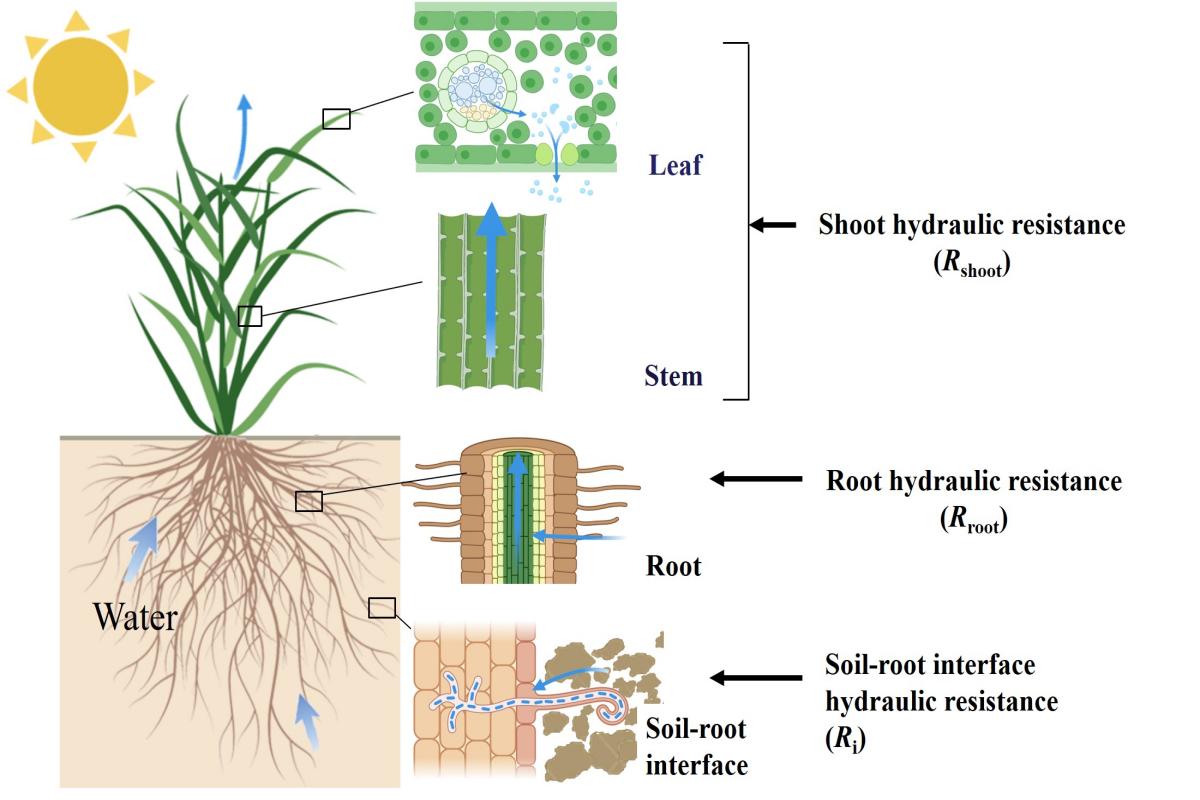南湖新闻网讯(通讯员 杨裕涵)近日,华中农业大学彭少兵教授领衔的水稻栽培生理团队在期刊Plant Physiology在线发表了题为“Soil-root interface hydraulic conductance determines responses of photosynthesis to drought in rice and wheat”的研究论文。该研究揭示了根系形态结构与水力导度在调控水稻抗旱能力方面的作用机制。
水稻生产消耗了50%左右的农业用水,提高水稻抗旱性对于稳定粮食产量和提高水分利用效率具有重要的意义。关闭气孔是植物响应干旱胁迫的主要措施之一,尽管这种行为能够减少植物的水分散失,但同时也会降低光合速率并抑制植物生长。脱落酸信号和水力信号是植物调节气孔开闭的主要途径,近年来有大量研究表明干旱胁迫下气孔关闭与植株水力导度的降低密切相关。在土壤-植株-大气连续体中,植株水分传导阻力主要由根-土界面阻力、根系阻力和地上部阻力三部分组成。但是由于研究技术的限制,根-土界面阻力和根系阻力在植株水力系统中的占比及其对干旱胁迫的响应机制还缺乏系统的认识。

水稻水分传输阻力示意图
本研究以抗旱作物小麦为对照材料,系统分析了水稻和小麦的光合特性、植株水力导度、根系形态与解剖结构对干旱胁迫的响应。研究发现根-土界面阻力是两种作物水分传输的主要阻力,在水力系统中占总阻力的47.7%-50.7%;根系和地上部阻力分别占23.8%-24.8%和25.7%-28.5%。同时,根-土界面阻力对干旱胁迫的敏感性远高于另外两个阻力,根-土界面阻力的升高是驱动水力导度和气孔导度降低的主要因素。进一步研究发现,水稻根系皮层组织占根系横截面积比例较大,导致干旱胁迫下根系严重收缩,从而减少了根系与土壤颗粒的接触面积,这是造成干旱胁迫下根-土界面阻力升高的主要原因。因此,提高根系机械强度和维持根-土界面水力导度对于提高水稻抗旱能力至关重要,研究结果对于水稻抗旱栽培和育种具有一定的指导意义。

根系形态学和解剖学的可塑性对植物抗旱性调控的机制
华中农业大学植物科学技术学院博士研究生杨裕涵为论文第一作者,李勇教授为论文通论作者。该研究得到了国家重点研发计划(2022YFD2301404)和国家自然科学基金(32172103)的资助。
英文摘要:Rice (Oryza sativa) production consumes a huge amount of fresh water, and improvement of drought tolerance in rice is important to conserve water resources and to minimize yield loss under drought. However, processes to improve drought tolerance in rice have not been fully explored, and a comparative study between rice and wheat (Triticum aestivum) is an effective method to understand the mechanisms determining drought tolerance capacity. In the present study, we applied short-term drought stress to Shanyou 63 rice and Yannong 19 wheat to create a range of water potentials and investigated the responses of gas exchange, plant hydraulic conductance, and root morphological and anatomical traits to soil drought. We found that photosynthesis in rice was more sensitive to drought stress than that in wheat, which was related to differences in decline of stomatal conductance and plant hydraulic conductance (Kplant). The decline of Kplant under drought was mainly driven by the decrease of soil-root interface hydraulic conductance (Ki) because Ki was more sensitive to drought than root and shoot hydraulic conductance and the soil-root interface contributed to more than 40% of whole plant hydraulic resistance in both crops. Root shrinkage in response to drought was more severe in rice than that in wheat, which explains the larger depression of Ki and Kplant under drought stress in rice. We concluded that the decline of Ki drives the depression of Kplant and photosynthesis in both crops, and the plasticity of root morphology and anatomy is important in determining drought tolerance capacity.
审核人:李勇
